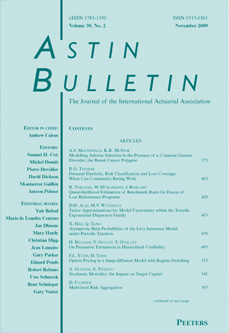 previous article in this issue previous article in this issue | next article in this issue  |

|
Document Details : Title: Dependent Loss Reserving Using Copulas Author(s): SHI, Peng , FREES, Edward W. Journal: ASTIN Bulletin Volume: 41 Issue: 2 Date: 2011 Pages: 449-486 DOI: 10.2143/AST.41.2.2136985 Abstract : Modeling dependencies among multiple loss triangles has important implications for the determination of loss reserves, a critical element of risk management and capital allocation practices of property-casualty insurers. In this article, we propose a copula regression model for dependent lines of business that can be used to predict unpaid losses and hence determine loss reserves. The proposed method, relating the payments in different run-off triangles through a copula function, allows the analyst to use flexible parametric families for the loss distribution and to understand the associations among lines of business. Based on the copula model, a parametric bootstrap procedure is developed to incorporate the uncertainty in parameter estimates. To illustrate this method, we consider an insurance portfolio consisting of personal and commercial automobile lines. When applied to the data of a major US property-casualty insurer, our method provides comparable point prediction of unpaid losses with the industry's standard practice, chain-ladder estimates. Moreover, our flexible structure allows us to easily compute the entire predictive distribution of unpaid losses. This procedure also readily yields accident year reserves, calendar year reserves, as well as the aggregate reserves. One important implication of the dependence modeling is that it allows analysts to quantify the diversification effects in risk capital analysis. We demonstrate these effects by calculating commonly used risk measures, including value at risk and conditional tail expectation, for the insurer's combined portfolio of personal and commercial automobile lines. |
